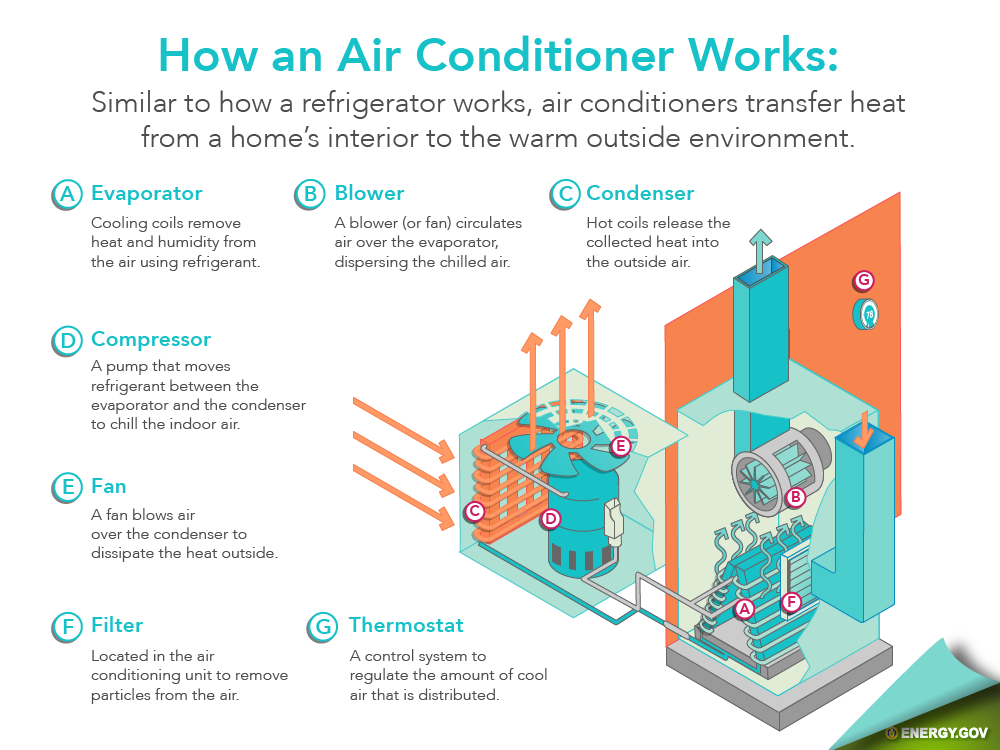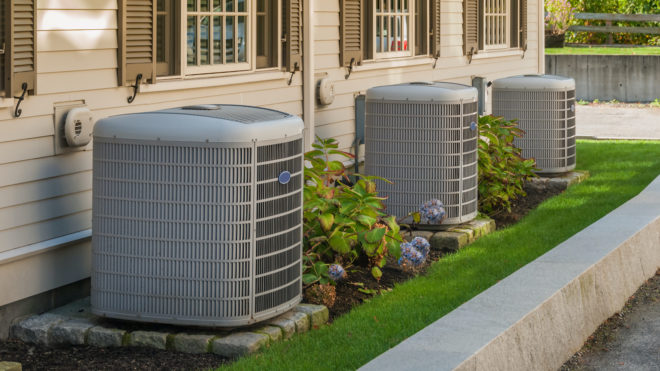Willis Carrier developed the first modern air-conditioning system on July 17th, 1902. The invention by Carrier has helped to bring forth numerous industries that continue to power our economy today. In the early years, air conditioning helped improve the production of everything from baked goods to food and other supplies. It supported summer movie blockbusters as people rushed to the cool theatres to escape the heat.
Precise temperature and humidity control have even facilitated the development of indoor shopping malls, transatlantic flight, and internet-enabled computers and servers. Today’s “modern” cooling systems keep operating on the same fundamental principles, providing people inside with comfortably chilled air. Even though air conditioning is all around us, the average person does not know how they actually work.
How Air Conditioners Work Overview
Air conditioners come in a range of sizes and shapes, but all function in the same basic principle. An air conditioner delivers fresh air inside your home or enclosed space by extracting heat and moisture from the indoor air. It returns the cooled air to the indoor space and disburses the unwanted heat and humidity outside. A standard air conditioner or cooling system uses a particularly sophisticated refrigerant chemical and also has three main mechanical components: a compressor, a condenser coil, and an evaporator coil. These components work together to transform the refrigerant quickly from gas to liquid, and then back again.
The compressor elevates the refrigerant gas pressure and temperature and sends it to the condenser coil, where it is converted to a liquid. The refrigerant then flows back indoors and enters the evaporator coil. The liquid refrigerant evaporates here and cools down the coil inside. A fan blows indoor air over the cold evaporator coil of the system, where heat inside the building is absorbed into the refrigerant. The cooled air then circulates in the house, while the hot evaporated gas is returned to the compressor outside. The heat is later released into the open air as the coolant returns to a liquid state. The process continues until the ideal temperature required is reached.

The Air Conditioning Process
Many North American homes rely on split-system air conditioners, also referred to as “central air.” There are a variety of components in air conditioning systems, and they do more than just cool the air inside. Within your house, they can also monitor humidity, air quality, and airflow. It will be helpful to know what constitutes a typical system before explaining how air conditioners work.
What is Central Air?
A conventional air conditioning system, often referred to as “central air” or “split air-conditioning system” includes typically:
- A thermostat that controls the operation of the system.
- Outdoor unit housing a ventilator, condenser coil and compressor.
- An indoor unit that houses an evaporator coil and a ventilator to circulate the cooled air.
- A copper tube which allows coolant to flow between the indoor and outdoor units.
- An expansion valve that controls the amount of coolant entering the evaporator coil.
- A duct is allowing air to flow from the indoor unit to the various living spaces and back to the indoor unit.
In its purest form, the air conditioning cycle requires two acts that occur concurrently, one within the home and one outside the house.
Inside the home,quite often referred to as the “cold side” of the system, moist indoor air is cooled as it flows over a cold cooling coil full of refrigerant. The heat from indoor air is swallowed up into the refrigerant as the refrigerant turns from liquid to gas. The refrigerated air is distributed back into the house.
Outside the home, quite often referred to as the “hot side” of the system, the refrigerant gas is compressed before entering a large coil in the outdoor unit. Heat is released outside as the refrigerant converts to liquid, and a large ventilator draws outdoor air through the external coil avoiding the heat absorbed from the apartment.
The result is a continual process of heat and moisture being removed from indoor air, cool air coming back home, and heat and humidity exiting the home.
In More Detail, How Does Central Air Work
Now that you have a solid understanding of how air conditioners work let’s dig deeper and describe the workings of the whole process.
The thermostat, which is usually mounted in a central location on a wall inside the home, controls indoor air temperature. The process of cooling starts when the thermostat senses that the air temperature needs to be reduced and sends signals to the components of the air conditioning system both inside and outside the home to start working. The indoor unit fan pulls hot air from inside the house via return air ducts. This air passes through filters where it collects dust, lint, and other airborne particles. Then the filtered, warm indoor air passes over the cold evaporator coil. Since the liquid refrigerant within the evaporator coil converts to gas, indoor air heat is absorbed into the refrigerant and cooling the air as it passes through the coil. The blower fan of the indoor unit then pumps the chilled air back into the different living areas through the home’s ductwork.
The refrigerant gas exits the home via a copper tube and passes through the compressor in the air conditioner unit outside. Think of the compressor as an electric huge pump. The compressor pressurizes the refrigerant gas and brings the coolant into the condenser coil in the outdoor unit. A massive fan draws hot air into the condenser tube, allowing the air to capture heating energy from home and release it outside. The refrigerant is transformed back to a liquid during this process. It then runs back to the indoor unit via a copper tube where it passes through an expansion device which controls the refrigerant flow into the evaporator coil. Then the cold refrigerant emits more heat from the indoor air, and the process continues.
Types of Air Conditioners
As you can see, the question “how do air conditioners work” can lead to a very simple or very complicated explanation. It’s the same as discussing different types of air conditioners. As indoor living spaces come in a variety of shapes and sizes, from the new tiny homes of today to 30,000 square foot estates, residential air conditioning systems are also available to match in various styles and configurations. There are three main types of air conditioner– air conditioner with split-system, packaged air conditioner, and ductless air conditioner. Each has its specific uses, but they all do the same thing in essence – make it cool inside your home. The type of cooling system that works best for you will depend on your geographical area, your home’s size, and physical limitations and how you use it.
Split-System Air Conditioner
Air conditioners with split systems give the most common answer to the question, “what is central air?” These types of systems have the inside unit as well as an outdoor unit. Usually, a furnace or fan coil, the indoor device consists of the evaporator coil and blower fan (air handler) that circulates air in the building. The outer unit houses both the compressor and the condenser coil.
Split-system air conditioners offer a range of products, including basic single-stage systems, quieter and more efficient two-stage systems, and the most silent multi-stage systems that would save the most energy. A split system air conditioner provides continuous, active regulation of the temperature for the entire house. And, because the system uses indoor air handler filters, it can clean your air while it is cooling.
Packaged Air Conditioner
Packaged air conditioner systems include everything in one unit from the evaporator coil to the blower fan, the compressor, and the condensing coil. They work well when the indoor unit of a split-system air conditioner doesn’t have enough space in an attic or closet. In areas where rooftop installations are preferred, they ‘re also a great choice. Like split systems, packaged systems draw warm air from home into the section of their evaporator coil, via return air ducts. The air passes over the evaporator coil, and the cooler air returned to the house via the supply air ducts. And, like with a split system, through the condenser coil, the unwanted heat is released outside.
Whatever system type works for your home or property, knowing how air conditioners work will help you identify a system that makes the most sense. And, it will enable you to understand better the choices that your HVAC contractor presents.

